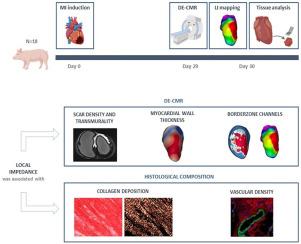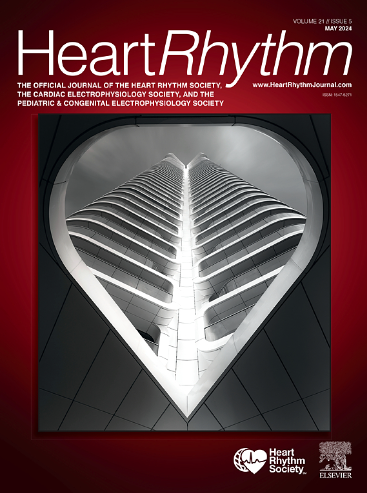Tissue characteristics underlying endocardial local impedance subtypes in chronic myocardial infarction
IF 5.7
2区 医学
Q1 CARDIAC & CARDIOVASCULAR SYSTEMS
引用次数: 0
Abstract
Background
Local impedance (LI) mapping is feasible and provides additional tissue characterization of the ventricular tachycardia substrate. Data on tissue composition underlying the LI spectrum are lacking.
Objective
To describe the tissue composition underlying different LI subtypes in a chronic myocardial infarction (MI) swine model.
Methods
One month after non-reperfused anterior MI, 18 Landrace Large White pigs underwent delayed-enhancement cardiac magnetic resonance (DE-CMR) and endocardial left ventricular (LV) LI mapping. DE-CMR images were post-processed off-line to obtain LV wall thickness, scar subtypes, and border zone (BZ) corridors, and were co-registered with LI maps. Tissue samples were obtained from abnormal LI sites.
Results
Low LI zones exhibited more pronounced wall thinning compared to intermediate LI tissue (2.8 ± 0.7 vs 3.8 ± 0.9 mm; P < .001) and correlated with DE-CMR dense endocardial scarring (91.4%) and with epicardial scarring (75% dense and 24% BZ tissue). Intermediate LI tissue exhibited predominantly subendocardial scarring, with more heterogeneous distribution (45% dense, 47% BZ, and 8% healthy tissue) and less epicardial involvement (73% healthy tissue). Most DE-CMR BZ corridors (75.6%) colocalized with intermediate LI tissue. Histologically, tissue from intermediate LI zones displayed less collagen I (P = .008), collagen III (P = .053), and collagen volume fraction (P = .021), and greater vascular density (P = .075), compared to low LI zones.
Conclusions
Areas of low LI had a higher proportion of dense, transmural scar and wall thinning compared to intermediate LI areas. DE-CMR BZ corridors colocalized with intermediate LI in most cases. LI subtypes showed distinctive histological composition.

慢性心肌梗死的心内膜局部阻抗亚型的组织特征。
背景:局部阻抗(LI)映射是可行的,并提供额外的室性心动过速基底的组织特征。缺乏LI谱下的组织成分数据。目的:探讨猪慢性心肌梗死(MI)模型中不同LI亚型的组织组成。方法:非再灌注前路心肌梗死1个月后,18头长白猪进行了延迟增强心脏磁共振(DE-CMR)和心内膜左心室(LV) LI制图。DE-CMR图像离线后处理,获得左室壁厚度、疤痕亚型和边界区(BZ)走廊,并与LI地图共同注册。组织样本取自LI异常部位。结果:低LI区比中等LI区表现出更明显的壁变薄(2.8±0.7 vs 3.8±0.9 mm;P < 0.001),并与DE-CMR致密心内膜瘢痕(91.4%)和心外膜瘢痕(75%致密和24% BZ组织)相关。中间LI组织主要表现为心内膜下瘢痕形成,其分布更不均匀(45%致密组织、47% BZ组织和8%健康组织),心外膜受累较少(73%健康组织)。大多数DE-CMR BZ走廊(75.6%)与中间LI组织共定位。组织学上,与低LI区相比,来自中等LI区的组织显示出较少的I型胶原(P = 0.008)、III型胶原(P = 0.053)和胶原体积分数(P = 0.021),以及较大的血管密度(P = 0.075)。结论:与中等LI区相比,低LI区致密、跨壁疤痕和壁薄的比例更高。DE-CMR BZ走廊在大多数情况下与中间LI重合。LI亚型具有独特的组织学组成。
本文章由计算机程序翻译,如有差异,请以英文原文为准。
求助全文
约1分钟内获得全文
求助全文
来源期刊

Heart rhythm
医学-心血管系统
CiteScore
10.50
自引率
5.50%
发文量
1465
审稿时长
24 days
期刊介绍:
HeartRhythm, the official Journal of the Heart Rhythm Society and the Cardiac Electrophysiology Society, is a unique journal for fundamental discovery and clinical applicability.
HeartRhythm integrates the entire cardiac electrophysiology (EP) community from basic and clinical academic researchers, private practitioners, engineers, allied professionals, industry, and trainees, all of whom are vital and interdependent members of our EP community.
The Heart Rhythm Society is the international leader in science, education, and advocacy for cardiac arrhythmia professionals and patients, and the primary information resource on heart rhythm disorders. Its mission is to improve the care of patients by promoting research, education, and optimal health care policies and standards.
 求助内容:
求助内容: 应助结果提醒方式:
应助结果提醒方式:


